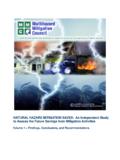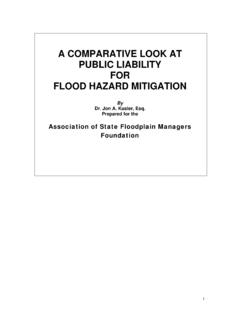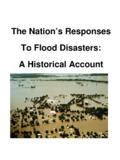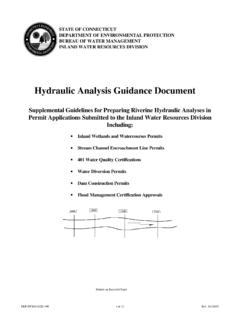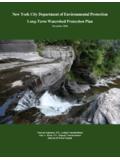Transcription of Initial Restoration for Flooded Buildings - floods.org
1 Initial Restoration for Flooded Buildings HURRICANE KATRINA RECOVERY ADVISORY. NOTE: This advisory is speci cally intended for Buildings subject to the effects of long-term ooding and widespread mold growth following Hurricane Katrina. For additional information on more common water leakage and mold situations, refer to the FEMA website ( gov) and related links to the Environmental Protection Agency (EPA) and the Centers for Disease Control and Prevention (CDC) sites listed at the end of this advisory. During the Initial visit to a ood-damaged building , the situation often appears overwhelming (Figure 1).
2 However, despite the shock that often accompanies an individual's rst look at the damage, there are a number of straightforward principles can be applied to assist with the ood Restoration effort. In addition to following the steps outlined below, individuals should review the Hurricane Katrina Recovery Advisory, The ABC's of Returning to Flooded Buildings . 1. Air Out To promote drying, open all doors and windows whenever you are present and leave as many open when you are not present as security concerns allow. Some styles of windows (double-hung) and patio doors may be able to be left partially open and Figure 1.
3 Typical ood damage to furniture and interior walls secured from external opening by inserting a nail in the (Hurricane Katrina). window frame or using a wooden dowel or stick. Upper oor windows can usually be left open all the time and will also assist in drying the whole house. Try to take advantage of cross-ventilation by opening windows on multiple levels and opposite sides of the building . Open interior doors, especially closets and interior rooms, to allow air movement to reach all areas of the building . Take doors off their hinges if necessary to promote air ow.
4 Open kitchen cabinet and bathroom vanity doors; remove drawers and stack them to dry. Open the attic access, if available, to increase ventilation. Consider the bene ts (improved drying) and risks (falling dust, insulation, or other debris) of adding an attic access where none exists. When electricity is available, use fans to push moist air outside. However, avoid use of fans if the house is contaminated with sewage as the air movement may spread bacterial contamination. 2. Move Out Remove salvageable contents that were not impacted by the water.
5 If the upper oors are dry, it may be possible to move such items to those areas. When moving items from impacted areas of the building to other locations, consider using protective mats or non-slip drop cloths ( , fabric painter cloths) to avoid contamination of unimpacted surfaces. Remove saturated porous materials such as mattresses or upholstery, especially those with visible fungal growth. These items should be moved out of the building as soon as possible. Cover contaminated items with plastic drop cloths prior to moving to prevent spread of contaminants.
6 Appropriate personal protective equipment should be utilized to avoid injury from possible exposure to mold and bacteria. Initial Restoration for Flooded Buildings November 2005 Page 1 of 4. 3. Tear Out Prior to beginning tear out, install plastic barriers between affected and unaffected areas of the premises (typically between the rst and second oors). This will reduce the potential for secondary damage occurring in the unaffected areas. Remove wet carpet and padding. Tack strips should also be removed completely when the carpet is taken out to minimize injury during subsequent activities.
7 Since carpet tack strips have protruding nails, wear leather gloves to protect hands from puncture wounds while removing and handling tack strips. Removing wooden baseboards prior to carpet tear out may allow for their later reinstallation. Remove any curled vinyl tiles or linoleum over concrete oors, and remove all vinyl tiles or linoleum over wooden sub- oors to allow the wood to dry. Respiratory protection should be worn as many older (pre- 1970s) ooring products, such as 9-inch square tiles and adhesives, often contain asbestos.
8 Although punching holes in walls for drainage is commonly recommended, this practice does not drain water nor does it cause the wall to dry faster. If holes are not punched in the walls, the drywall (gypsum board). may be able to be easily repaired and restored. If drywall or plaster has been saturated by contaminated oodwater, it should be removed. Respiratory protection should be worn when removing drywall as some older drywall joint compound contains asbestos. If the water level was less than 2 feet, the wall material should be removed to a height of 4 feet to facilitate reinstallation of full sheets of drywall.
9 If the water level was greater than 2 feet, the wall material should be removed to a height of 8 feet or the ceiling junction, whichever is higher. Electrical outlet and wall switch plates and door and window moldings must be removed prior to the tear out of the wall material. Fibrous wall insulation ( berglass, mineral wool, cellulose, wood berboard, etc.) saturated by oodwater should be removed completely. Foam plastic insulation may be left in place and allowed to dry. Flooded electrical receptacles should be removed completely after the appropriate circuit breakers or fuses are deactivated.
10 Wall paneling should be removed if it is swollen or if saturated drywall is behind the paneling. 4. Clean Out Following any necessary tear out, clean up any remaining debris and muck. Squeegees, shovels, and brooms are effective for such cleaning. Personal protective equipment should be utilized. Detailed cleaning and sanitizing of the remaining materials should be conducted. A shop vacuum with dry lters in place and with a solution of clean water and disinfectant in the tank (2-inch depth) to minimize the spread of dust can be used.

